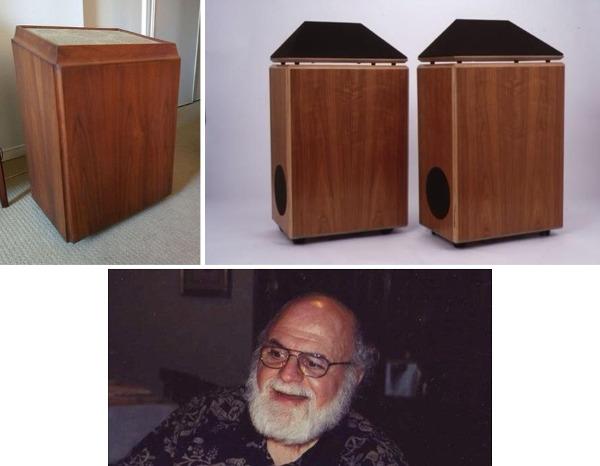Richard Shahinian R.I.P.

But as the old-wives-tale suggests about things hitting in threes, we also lost a third. Loudspeaker designer Richard Shahinian passed away in November 2017. If you're less familiar with his name, you shouldn't be. Very much rebel with a cause, Richard championed a type of speaker design far less widely accepted than the normomnidirectional (or perhaps more accurately, polydirectional, as a true omnidirectional speaker, a point source that radiates equally in all directions, is physically impossible to make with any current or anticipated technology). He was an avid disciple of the late Stu Hegeman, an early audio icon who also championed this type of design.
As a budding audiophiIe I first met Richard at a hi-fi show in Palo Alta CA in the '70s. He was demonstrating the then new Harman Kardon Citation 13 (top left in photo), a largely upward-radiating loudspeaker. I was so stunned by their top-end openness and bass slam (the latter using a double chamber reflex design, I later learned) that I can't recall anything else from the show.
Much later Richard told me that the Citation 13, which then sold for $600/pair (a pricey speaker then!), wasn't a big hit on the market, and only roughly 300 pairs were ever sold. I ultimately owned a pair of them, and while they were never quite right for the space I then lived in, and a pending move meant I had to sell them, I've always wondered if a little more space and other massaging might have helped them reach their considerable potential. The drivers, some of the best available at the time, included three 6-inch Philips woofers, two Philips dome tweeters, and a dome midrange of unknown (to me) origin. I've pondered what they might sound like today with more modern drivers and a little more attention paid to comb filtering between them, not to mention cabinet edge diffraction. Both characteristics were largely ignored by speaker designs of the time. (Shahinian's Arc 2, a much later design still in the company's lineup, looks a bit like a refined but much smaller version of the 13.)
I eventually gravitated to the more widely available front radiating loudspeakers. I even made a few attempts at making my own speakers (one of them polydirectional!), with limited success. Richard moved on from Harman Kardon, first designing more conventional loudspeakers for Rectilinear Research and, shortly after that, starting his own company, Shahinian Acoustics, dedicated to marketing the sort of speakers he wanted to make. I actually reviewed his company's first effort, the Obelisks, in my tiny-circulation, long- defunct audio publication, StereOpus (one of many such "underground" print pubs at the time, some of which, including a flood of new ones, still exist on the Internet today).
Over the next 20 years or so I ran into Richard and his speakers every year at CES. His demos were always worth at least an hour or so, particularly after he created his magnum opus, the imposing Diapasons (top right in photo). If there was one thing that Richard enjoyed more than designing loudspeakers it was using them to listen to great music, and at CES that music was invariably full symphony orchestra recordings for which the Diapason's were ideally suited with their stunning spaciousness and dynamics. Richard arguably knew this sort of music as well as (and likely better than) better than anyone else in the industry, and seemed particularly fond of British composers including Vaughan Williams, Britten, Elgar, and Holst. I asked him once about orchestral film scores (some readers will recognize this genre as a favorite of mine) He had praise for Jerry Goldsmith, but described John Williams as "a thief." Too harsh, I thought, but by that I'm sure he meant that Williams borrowed heavily from the classics, as have many time-pressed film composers over the years. Richard could recognize those borrowings immediately.
During my CES visits to Shahinian's room I often ran into Stereophile's founder, the late J. Gordon Holt, who year after year was equally impressed by the sound there. When I was working for Stereophile in the early '90s I helped coordinate Gordon's review of Shahinian's Diapasons. I've long regretted that it didn't come off well, but Shahinian's designs still have passionate supporters for whom they push all the right buttons. In 2004 John Marks, in his Stereophile column, discussed the Shahihian Hawk, a smaller version of the Diapaisons, in far more favorable terms. Both reviews can be found on the Stereophile website.
By the early 2000s Shahinian had stopped demonstrating at CES. His company's presence and dealer base was relatively small in the US and concentrated overseas. The market also pushed his prices markedly higher, as it has much of the high-end. I missed him at shows, and wish I had later kept in touch. His product line remained the same over the ensuing years, with no new models but ongoing refinements to existing ones. With his passing, the company remains, run by his son Vasken. Its website, despite being little updated, remains a strong voice for Richard's design philosophy and pride in how he implemented it in his designs. It also includes a list of some of his recommended orchestral recordings
If there's any justice in the universe, Richard, Arnie, and Charley have now found a comfortable spot somewhere for endless discussions about music, musicians, and the future of audio. They may no longer contribute to any of it, but their legacy has left indelible marks.
























































